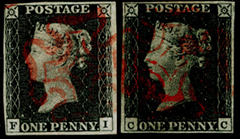 First Issues Collectors Club
of stamps and philatelic material
First Issues Collectors Club
of stamps and philatelic material
Home - Catalog - Categories - Index - Journal - Exhibits - Auctions - Forgeries - Join
 First Issues Collectors Club
of stamps and philatelic material
First Issues Collectors Club
of stamps and philatelic material
Home - Catalog - Categories - Index - Journal - Exhibits - Auctions - Forgeries - Join
| first issues > countries > usa |
Imperforate, unwatermarked, engraved.
Printed by Rawdon, Wright, Hatch and Edson.
| Description | # printed | # issued | Scott | SG† | Mi | Y&T |
|---|---|---|---|---|---|---|
5 cents red brown on thin bluish paper |
4,400,000 | 3,717,500 | 1 | 1 | 1 | |
10 cents black on thin bluish paper |
1,050,000 | 892,802 | 2 | 2 | 2 |
† Scott (sc1a-d) and especially Gibbons (SG1a-g) identify colour variants and shades in the first US stamp.
All issue quantities are approximate.
The stamps were ready for delivery to the Post Office
Department on June 26. They were printed in sheets of two panes
of 100 stamps each.
| Date | Place | Copies of 5¢ | Copies of 10¢ |
|---|---|---|---|
July 1 |
New York City |
60,000 | 20,000 |
July 2 |
Boston |
40,000 | 10,000 |
July 7 |
Philadelphia |
40,000 | 10,000 |
July 9 |
Washington, D.C. |
3,000 | 1,000 |
July 16 |
Baltimore |
500 | ? |
July 23 |
Baltimore |
? | ? |
The deliveries were "interrupted" by the Fourth of July celebrations.
| Value | Minimum ~ 3% | Maximum ~ 6% | On cover |
|---|---|---|---|
5¢ |
110,000 | 225,000 | 15,000 |
10¢ |
25,000 | 55,000 | 3,500 |
Most estimates use a survival rate of between three and six percent. Numbers are rounded.
| Printing | # printed | Description |
|---|---|---|
| The brown ink used was abrasive and thus caused plate wear. | ||
| I | 600,000 | Clear, proof-like impressions as well as the presence of dark brown and black brown hues, including the rare, almost black 'seal brown', known on the very early July 9, 1847 Ishakawa cover. |
| II | 800,000 | Ordered on May 13, 1848. It was the printing distributed to route agents on the rail lines. Typical colors are brown and pale brown. Impressions are less crisp than the first printing but still very good. |
| III | 1,000,000 | Ordered March 19, 1849. It is well-known for its worn, dirty impressions. Colors include the grayish browns and worn red browns. |
| IV | 1,000,000 | Ordered February 14, 1850. It was made after the plate had been cleaned by an acid bath so that impressions are softer and fuzzy but clear. The 5¢ ink formulation was also changed to include chrome orange. Both the fourth and the fifth printing yield brown orange stamps which will 'dip' orange. |
| V | 1,000,000 | Ordered December 7, 1850. This printing includes the very rare orange and the rare red orange hues. The A.B. Slater 'orange' was the first imported of that shade. There is also a peculiar 'stressed' brown orange, typically and properly sold as orange brown. |
| Printing | # printed | Description |
|---|---|---|
| I - IV | 1,050,000 | The 10¢ printings are not readily distinguishable. The first printing had razor-sharp impressions, but even the last, the fourth, 10¢ printing has distinct, clear impressions. Plate wear from the non-abrasive black ink was minimal and the quantity printed was less than 25% of the 5¢. The 10¢ color variations are probably the result of lighter or heavier inking. |
Image from David Olson.
| FI ref: 7 | Page credit: JA |
| Page created 19 Feb 2014 | Page updated 20 Jan 2016 |